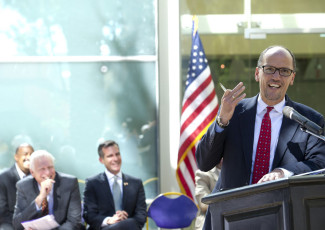Revamped Job Training Programs Lure More Students
By Corey Murray
March 14, 2014
With the help of a $500,000 federal grant, Illinois’ Waubonsee Community College is overhauling its advanced-manufacturing program in hopes of attracting more students. The college joins a growing list of institutions investing in new courses and facilities to secure future enrollments and satisfy economic demand.
With enrollments beginning to decline in the face of a resurgent economy and budgets being stretched to the brink, you might think that investing in new job-training programs and facilities would be the last thing on administrators’ minds.
But the old do-more-with-less mentality has done little to dampen enthusiasm at Illinois’ Waubonsee Community College (WCC), which recently used a $500,000 grant to update and restructure its outdated advanced-manufacturing program.
In an interview with The Beacon-News, Suzette Murray, the college’s assistant vice president of career and technical education, said the investment was necessary to keep up with economic demand in the region. Employers “are beating down our door, asking us to train students,” she told reporter Kalyn Belsha.
The college has not been shy about spending to satisfy that demand. Last summer, administrators plunked down more than $500,000 — part of a $12.9 million U.S. Department of Labor grant awarded to a statewide manufacturing consortium — to upgrade its machine laboratory, giving students access to the latest technology and training equipment, including a pair of precision CNC machines, computer-based tools for controlling complex industrial machinery.
The college also hired a new full-time manufacturing instructor who will teach classes and serve as a conduit between the college and local manufacturers, helping secure internships for students and keeping the college apprised of budding job opportunities.
The new investments have also led to changes in the curriculum. The college recently approved a new advanced-manufacturing degree in addition to four new professional certificate programs that will teach workers how to use the latest machinery.
Murray said the new programs and resources will pair with the college’s existing advanced-manufacturing offerings, from computer-aided drafting to welding, to create a comprehensive program designed to highlight the sophistication of today’s technology-centric manufacturing sector.
Such jobs took a hit during the recession, Murray said. But employers are starting to hire again — often in droves — and it’s up to community colleges to make sure students are prepared for such opportunities.
“We’re trying to recreate real workplace situations for the students,” Murray told the News.
Paying for it
WCC isn’t the only community college that has attempted to attract new students and employer interest by upgrading its programs and facilities.
Across the country, community colleges are using grant money, tapping into capital construction budgets and raising funds through fees and other means to modernize their campuses, even as state and federal funding dries up.
The Kentucky Community College and Technical System (KCTCS) recently unveiled plans for a new student fee, part of a larger bond measure, that would help pay for much-needed upgrades and construction projects at the state’s 16 community and technical colleges.
According to an article in the Courier-Journal, the fee is scheduled to kick in next year at $4 a credit hour and increase to $8 a credit hour by the 2015–16 school year. As a result, students who attend community colleges full time (at least 15 credit hours) can expect to pay $120 or more in additional fees. That money would pay for about a quarter of Kentucky Gov. Steve Beshear’s BuildSmart initiative, which seeks to raise more than $145 million worth of nontax funds for deferred construction projects at the state’s community and technical colleges. Additional funds for BuildSmart would come from local communities through public and private sources.
“Our community and technical college system is one of our most important tools in building a stronger, more agile and adaptable workforce,” Beshear said. “Yet, as our campuses have swelled with students, we haven’t been able to keep up with the system’s broad infrastructure needs.”
KCTCS president Michael McCall, who worked with the governor to drum up initial support for the program, told The Paducah Sun that BuildSmart is a prime example of the good that can come from communities and the colleges’ other stakeholders working together, (subscription-only) saying, “It builds upon the strong connections our colleges have forged with local business communities.”
In New Jersey, students and administrators at Raritan Valley Community College (RVCC) recently celebrated the opening of the Ray Bateman Center for Student Life and Leadership.
Described on NJ.com as “a three-story structure designed to be a central meeting place for students and student clubs,” the 24,000-square-foot facility, named after a former state senator and current member of the RVCC board of trustees, cost $5.8 million and was paid for with public and private donations.
Administrators say the building will serve as a hub for students to gather and share ideas.
“It is true from the research that’s out there that students succeed better in college and perhaps in life if they have interests to engage them outside of the classroom, and student clubs are a terrific way … to do that,” said John Trojan, RVCC vice president for finance and facilities.
What steps has your college taken to upgrade its facilities and programs to meet the needs of its community?








